Lucifer, the fallen angel. In this post I'm trying to see how the
Devil was depicted in the early christian art, examining a period of
about 700 years; from the earliest surviving evidence to the time of
Dante of the 14th c. I've tried to gather most of the cases so maybe
to extract conclusions regarding the illustrated perspective.
Devil in the initial religious texts
up
next
We can identify three major themes of the appearance of evil in the New
Testament; themes that gave the inspiration for some illustrations.
Firstly Devil or Satan appears in the life of Jesus mainly around their
encounter in the desert; where Jesus, after being baptized by John the
Baptist, fasted for 40 days and nights. There the evil spirit found the
chance and tried to tempt Christ, so to make him fall into sin. There were
three attempts: firstly, Satan challenged Jesus to turn some stones into
bread, so to satisfy his hunger. Then, he placed Jesus on the top of the
great temple of Jerusalem and urged him to fall so to prove his majesty.
Finally, ascending on a high mountain, he showed him the kingdoms of the
world, promising Jesus that he could have them, if he worshipped Satan.
The main narration comes from the gospels of Luke and Matthew, who are
naming the teasing spirit as both Devil & Satan [= Διάβολος, Σατανάς:
Luke 4:1–13,
Matthew 4:1–11]. Mark just mentions the temptations in the desert [Mark 1:13]; while only implications can be found in the gospel of John. Besides the
gospels, the scene was attached to the earlier
David's 90th psalm
[from the Old Testament], cause of a reference in the gospels' story; and
thus it can be found depicted in psalters, too. In any case this is the
theme that gave the majority of the medieval illustrations.
• The name Devil [= Διάβολος] seems to be the greek
translation of the hebrew Satan [= Σατανάς]; a conclusion that can be
derived by comparison of the greek and hebrew versions of the Old
Testament [especially in
Job 1—2,
Zech 3:1-2; cf.
Walton [2008]
& Septuagint in the relevant passages].
Another Satan's epiphany seems to be narrated around Judas' betrayal; Luke
and John are mentioning that it was the Devil who made Judas to commit it,
after possessing him [Luke 22:3,
John 13:2]. Judas' possession and following suicide was a scene that sometimes
worked as an interpretation of some lyrics of the older
108th psalm
[from the Old Testament], and thus can be found depicted in the psalters,
too. However, it's a rare illustrated theme.
Generally, possessions and following exorcisms by Jesus are recounted in all
the three synoptic gospels [Matthew, Luke & Mark]; but those possessions
were made by demons or unclean spirits, not the Satan exactly. Αlthough this
theme gave maybe the earliest illustrated example, it has less instances
compared to the temptations.
• Nevertheless, it's characteristic that at an
instance Jesus is accused that he's exorcizing the evil spirits in the
name of Beelzebul, the lord of demons [Matthew 12:24-26,
Mark 3:22-23,
Luke 11:15-18]. In his defense he asks: "How can Satan drive out Satan?" My first
thought was that the word Satan could be used as a quality, an adjective;
not only for the leader of evil. And it's typical that in some forthcoming
illustrated cases, both Satan and lesser demons could be depicted in a
similar way by the same artist, implying this more general use of the
term; but not always. A second thought was that the Devil was identified
somehow with Beelzebul, too, maybe in the same spirit of this general use
of Satan as evil. However, Beelzebul was according to the Old Testament a
Philistine deity; ie. foreign to Jews [Kings (4) 1:2-3, 6, 12].
Finally, in the Revelations of John, the great enemy appears, the
dragon-serpent with the seven heads [Rev 12:3-9]; and it's identified under both names, the Devil and the Satan. And
despite the fact that it's a narration of the earliest christian texts, it
seems taking some time to appear illustrated.
Identifying the Devil
up
next
The possibly earliest illustration of an evil spirit in christian art,
comes from the theme of exorcism; it's of late 6th c. and of eastern
origin [fig. 01]. But it's unclear what demon is depicted exactly.
The following later cases show definitely demons during exorcism, and
not the Satan...

|
|
fig. 02: Left: Exorcism in Capernaum [as in Luke 4:31–37], in
BSB Clm 4453, 'Evangeliar Ottos III', Reichenau GER [HolRomanEmp] -
1000 CE ca, f. 149v. Middle: Exorcism in Capernaum [as in Mark 1:21–28], in
RBME Vitrinas 17, 'Codex Aureus of Speyer', HolRomanEmp - 1050 CE ca,
f. 64r. Right: exorcism by Jesus, in
BNF Grec 923, 'Sacra Parallela', Constantinople [ByzEmp] - 2nd half
of 9th c., f. 211v
|
All these three [and other] depictions are giving the aspect of a dark
demon; perspective that we'll see being applied for the Devil, too,
especially in his early images. So, what were exactly his qualities, that
the artists had in mind?
Although Devil appears in the New Testament, his nature seems a little
unclear. His main attribute is this of the deceiver, who tries to lead souls
& minds into sin. As it would be expected, the early church fathers
connected the Devil with some creatures or/and angels of the Old Testament.
And though this possibly had an effect on how the Old Testament was also
seen, in this post I am restricting my focus only on the more clear cases of
the New Testament.
The first who tried a more updated approach is possibly Tatian of the 2nd
c. CE.; he spoke of a first-born demon [not using specifically the terms
Devil or Satan], who actually was the first angel who sinned and rebelled
against God, becoming the leader of the rest who followed him [Πρός Ἓλληνας VII: PG 6/819-821]. A little later, Irenaeus [2nd c. CE], without abandoning the connection
with the Old Testamanent, called him an 'apostate angel' [from Latin,
Contra Haereses 5.24.3: PG 7/1188]. While Tertullian of the early 3rd c. CE, suggested that he was the
wisest of all before he became the Devil [Adversus Marcionem 2.10: PL 2/296].
Generally since the 2nd c. CE many church fathers tried to approach the
nature of the Devil, such as Origen, Clement, Augustine. If I should extract
a more general view, this would be of a Devil as an angel, created by God,
who sinned by his own free will; a sin that led him to his fall. There was
also some discussion on the nature of his sin, with envy and pride mostly
suggested.
The aforementioned main lines of the angels' fall are depicted in a
beautiful way in the following manuscript...
It's an illustration of what is called Genesis A; a medieval english
version of the book of Genesis. A clear idea of a fallen angel. It's
noticeable the need of differentiation for when the angel became the Devil.
Here, it' s just declared with darker eyes and hair like flames, as seen in
the down part where Lucifer is in the mouth of Hell; and compared with the upper parts where he's still an angel. Generally,
in all the depictions of the Devil, this need of alteration, is obvious;
becoming more and more intense.
One of the few cases where this difference isn't that clear is the
following...
It's a detail from a 9th centrury psalter; specifically for the 108th
psalm. It's a depiction of a lyric about 'diabolus' standing at
the right hand of a sinner so to take him; not exactly possession. In
the Byzantine or generally eastern psalters, the sinner of this psalm
would be Judas. In any case, here the Devil is like an angel; he differs
to the rest angels of the bigger picture only regarding his less
clothes. It's almost unique case.
The tempting Devil
up
next
As it's already been said, the main theme where the Devil appears, is
around the Christ's temptations. I've tried to organize the relevant
findings based on the way that the Devil was illustrated.
The Devil more human [05 examples]
up
next
Possibly with an intention to underline the Devil's nature as deceiver.
But there're really few cases; all seeming coming from central Europe.
Regarding the differentiation of the Devil: in fig. 05 & 09 the Devil
is totally human. In fig. 06, in one of the three temptations, a small
tail can been seen. While in fig. 07 & 08 the Satan is just
darker.
The dark angel [12 examples]
up
next
Here, the Devil who tries to tempt Jesus, looks like an angel, but
darker. An illustrating way that mostly can be seen in Eastern examples;
but not only. However, the earliest maybe case, coming from Ireland or
Scotland [fig. 10], is a little unclear regarding the face of this angel,
while the body also seems skinny and eerie.
From a 9th c. psalter; left: the temptations from 90th psalm; right:
the Devil right of the sinner from 108th psalm...
From the following, besides fig. 15, all are of Byzantine origin.
Unfortunately, the Devil isn't always clear regarding the
head in the manuscripts. However, it seems that even in the worn off cases, in
most of them at least there aren't horns.
The temptations from the orations of Gregory of Nazianzus
From Sacra Parallela, a 9th c. Byzantine florilegium; temptations on
left, exorcism on right.
From a 9th c. Byzantine psalter: the temptations from 90th psalm. The
Devil with Judas as the sinner from 108th psalm...
Temptations on right, again Judas as the sinner of the 108th psalm on
left.
Maybe some start of making the Devil more monstrous; nevertheless a little
unclear. On left of fig. 18, the temptation of psalm 90; where the Devil
possibly could have horns [?]. But when he possesses Judas for psalm 108,
it's just messy hair.
Devil becoming monstrous in churches [06 examples]
up
next
Since the 12th century the Devil starts seeming more eerie in the
decoration of the churches. The examples are coming from mid-west Europe.
And the majority of them look a little more elegant than the manuscripts
of the 12th - 13th centuries. In the first example [fig. 21] the Devil has
horns, that are broken after his rejection and defeat, maybe underlining
that they were used as a sign of power; possibly of some pagan
perspective.
Devil becoming monstrous in manuscripts [06 examples]
up
next
In manuscripts, the aforementioned turn to a more monstrous shape of the
Devil seems taking place earlier and more freely. The dating and origin of
some of these examples made me think of a possible local pagan influence; as
a result of recent christianization of the areas. The first possibly case
comes from a Spanish cover book illustrating the temptations again. It's
said to be of the 9th century...

|
|
fig. 28: Detail of a Spanish Book-Cover Plaque by ivory, Asturias SPA -
dated in the 9th c., now in
Walters Museum [W.71.50]
|
The possibly first depiction of the Christ's enemy with horns and
goat-head seems to be of the 10th century from mid-Europe. However, it's
not the Devil but just Death [= Mors]. It's really possible a pagan
influence.
The fact that this Death is different from the Devil can be seen
illustrated in the following later manuscript coming from England. On left
it's death as opposite to life-Christ. On right is the Devil in the
temptation theme; nevertheless monstrous with pig-nose.
Another early evil creature with animal elements can be seen in the
following image. However it's unclear if it's the Devil or just a demon;
who is fighting for the soul of a man during the final judgement.
The earliest monstrous Devil in a manuscript's page that I've tracked
appears in the following two examples of the 11th century; both from
mid-Europe. In the first [fig. 32], the Satan has a body with few
animal-like elements and a snake tongue...
In the second [fig. 33], Devil is clearly a monster.
Devil as a monster during 12th & 13th centuries [22 examples]
up
next
During the 12th & 13th centuries Devil can be seen almost exclusively
as a monster in manuscripts. With the exception of the famous Codex Gigas
[fig. 55], all the following are of the temptation theme.
In the first example, along with temptations it's also given on right the
Devil with Judas committing suicide, for comparison...
The dragon of the Revelations [10 examples]
up
next
Christ's enemy in the Revelations of John [the seven headed dragon], took
some time to be seen illustrated in manuscripts. With one exception of the
11th century, all the rest came from the 13th.
An approach for an early final judgement - Ravenna, 6th c. [04
examples]
up
next
In a
wiki article
is presented a case of a possible early depiction of the Devil; taken from
Dendle [2001], p. 140, and mentioned as disputed.
The scene is taken from the gospel of Matthew [25:31-46], where Jesus in his glory separates the nations during the final
judgement, like a shepherd separates the sheep from the goats. The ones on
his right go to heaven as righteous, the others to the Devil and his
angels. Thus there's a possibility that the angel on Jesus's left is the
Devil, actually declared with a different color, blue.
This doesn't seem that probable to me, as this angel still has a halo
over his head; a little inappropriate for the Devil.
Though it isn't a solid proof, in similar depictions of the final judgement
that I've tracked, either there's no Devil obviously, or he's clearly
different. However, they aren't depicting this specific parable.
The Devil by Dante [03 examples]
up
next
I set as a limit the Divine Comedy by Dante Alighieri of the early 14th
century [1320 CE ca]. It seemed to me rational as it's maybe the most
popular piece of literature, or at least renowned, that suggests a somehow
altered version in demonology. Nevertheless it's a poetic allegorical work,
not a theological one, like for example Augustine's Civitate Dei. In Dante the Devil has three heads [Inferno: Canto XXXIV]...
References: [up]
-
Dendle, Peter [2001], Satan Unbound: The Devil in Old English Narrative
Literature, 2001
-
Martin, Dale Basil [2010], When Did Angels Become Demons?, in Journal of
Biblical Literature, Vol. 129, No. 4 (WINTER 2010), pp. 657-677
-
PG: Patrologia Graeca [Migne]
-
PL: Patrologia Latina [Migne]
-
Russell, Jeffrey Burton [1987], Satan: The Early Christian Tradition,
1987
-
Schiller, Gertrud [1971], Iconography of Christian art, Volume 1,
1971
-
Walton, John H. [2008], 'Satan' in Dictionary of the Old Testament:
Wisdom, Poetry & Writings: A Compendium of Contemporary Biblical
Scholarship, by Tremper Longman III, Peter Enns (eds.), 2008, pp.
714-717
-
The Temptations of Christ, web article in
imaginemdei.blogspot
































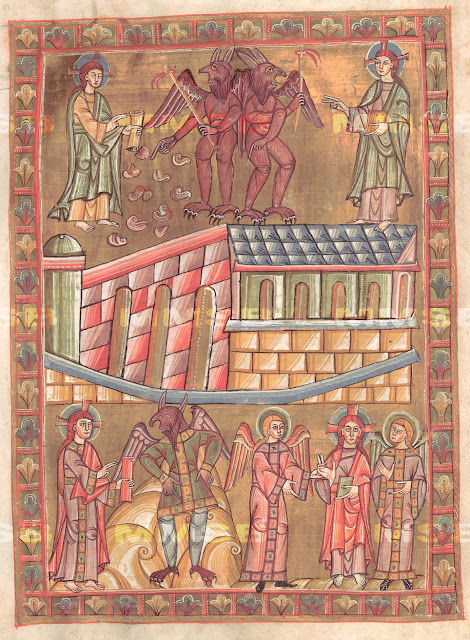

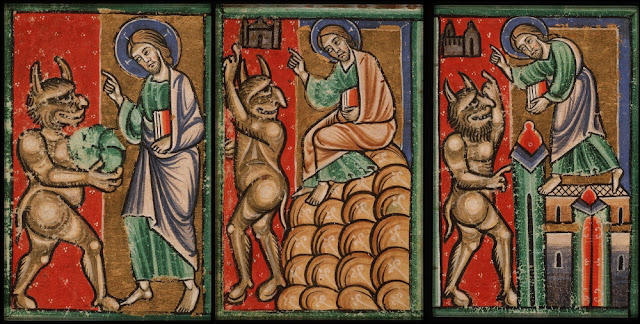





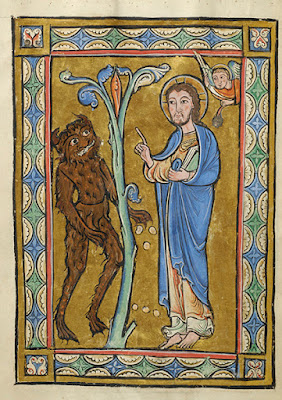




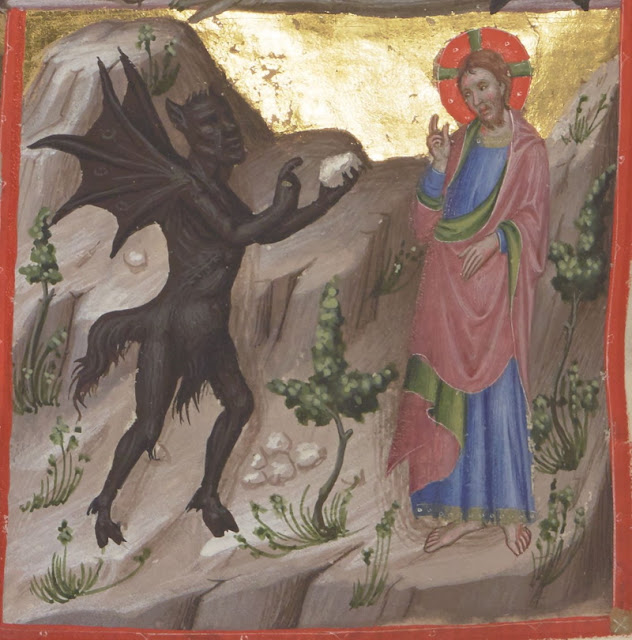





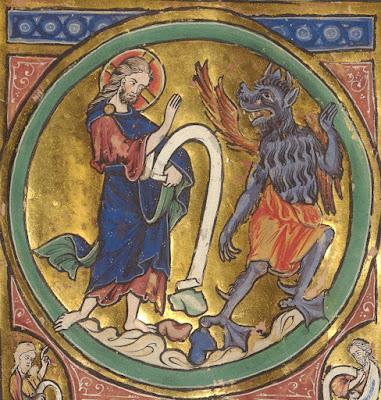











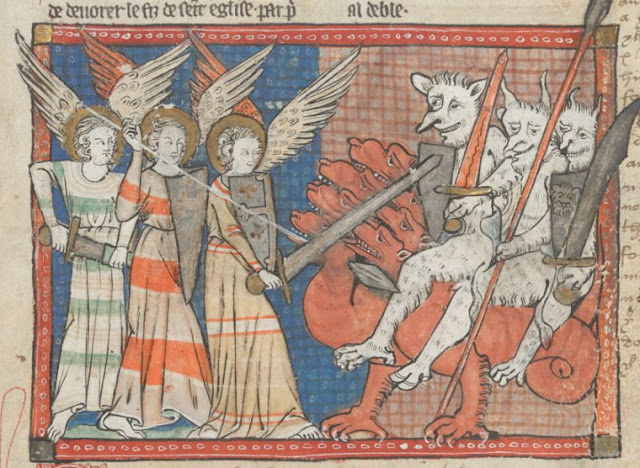










Comments
Post a Comment